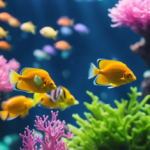Fish tank lighting is a crucial aspect of creating a healthy and thriving aquarium environment. Proper lighting not only enhances the visual appeal of the fish tank but also plays a vital role in supporting the health and growth of aquatic life. Understanding the different types of aquarium lighting available and their specific benefits can significantly contribute to the overall well-being of the fish and other inhabitants of the tank.
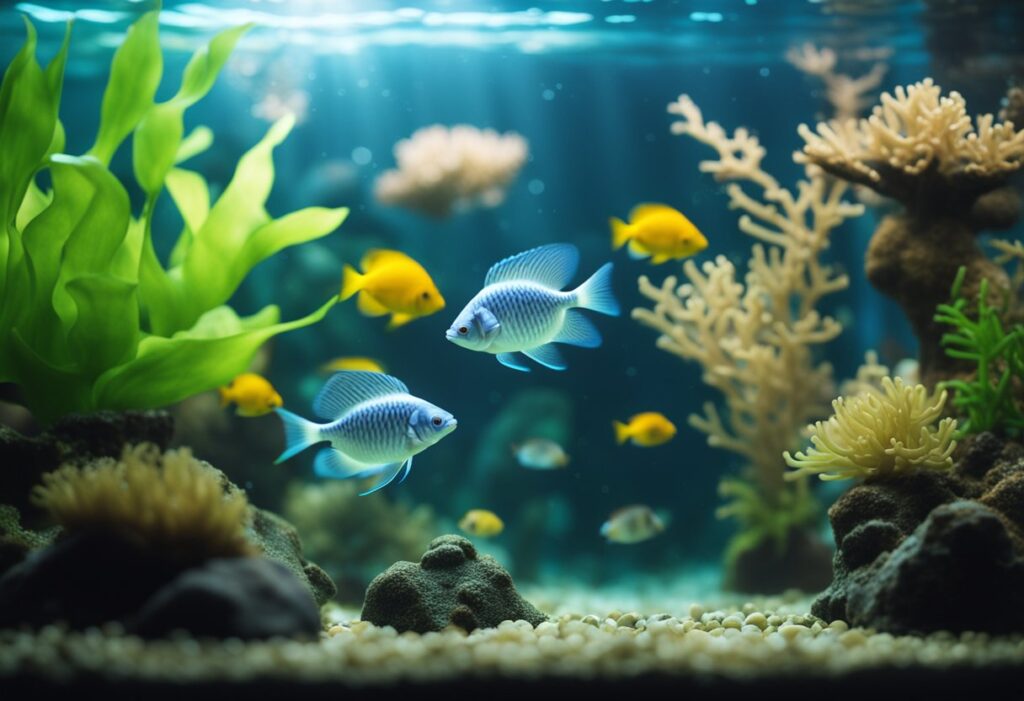
When it comes to fish tank lighting, there are various options to consider, each serving different purposes. Whether it’s providing adequate light for plant and coral growth, selecting the right lighting systems and controls, or ensuring the overall well-being of the aquarium inhabitants, the right lighting setup can make a significant difference. Additionally, maintenance and budget considerations are essential factors to keep in mind when planning the lighting for your fish tank, as they can impact the long-term sustainability and health of the aquatic ecosystem.
Key Takeaways
- Understanding the different types of aquarium lighting is crucial for creating a healthy and thriving fish tank environment.
- Proper lighting plays a vital role in supporting the health and growth of aquatic life, including plants and corals.
- Considering maintenance and budget factors is essential for ensuring the long-term sustainability and well-being of the aquarium inhabitants.
Fish Tank Lighting
| Product Short Name | Rating | Price |
|---|---|---|
| hygger Clip On 24/7 Lighting LED | 4.6 | $29.69 |
| Pawfly LED Light Full Spectrum | 4.6 | $9.99 |
| AQUANEAT LED Aquarium Light Full Spectrum | 4.5 | $16.99 |
| SEAOURA LED Aquarium Light for Plants | 4.5 | $26.99 |
| DaToo Submersible Aquarium Light | 4.5 | $8.99 |
| Gamalta Aquarium Light 14W Natural Mode | 4.5 | $24.99 |
| Lightahead Artificial Tropical Fish Aquarium Lamp | 4.2 | $37.99 |
| hygger 24/7 Mode Submersible Aquarium LED Light | 4.2 | $15.99 |
| TAISHAN Aquarium Clean Light | 4.3 | $18.98 |
| hygger Auto On Off LED Aquarium Light | 4.3 | $74.99 |
| DOMICA Clip On Aquarium Light | 4.3 | $9.99 |
| DaToo Aquarium Light Small LED Clip Light | 4.4 | $8.99 |
| COVOART LED Aquarium Light | 4.4 | $15.88 |
| S SMIFUL LED Aquarium Light | 4.4 | $12.99 |
| PULACO Fish Tank Air Stone with LED Light | 4.1 | $9.99 |
*Please note that prices are subject to change and may vary depending on the seller, location, and any applicable discounts or promotions. The ratings provided are based on customer reviews and may also change over time. Amazon Affiliate Link.
Types of Aquarium Lighting
When it comes to Fish Tank Lighting, there are several types of aquarium lighting that are commonly used. The type of lighting you choose will depend on the type of aquarium you have and the type of fish and plants you keep.
LED Aquarium Lights
LED lights are becoming increasingly popular for fish tanks due to their energy efficiency and long lifespan. LED aquarium lights are available in a wide range of colors and intensities, making them ideal for both freshwater and saltwater aquariums. They are also relatively easy to install and maintain.
Fluorescent Lighting
Fluorescent lighting is a popular choice for aquariums due to its affordability and versatility. Fluorescent bulbs are available in a variety of sizes and colors, making them suitable for most types of fish tanks. They are also energy-efficient and produce less heat than other types of lighting.
Incandescent Bulbs
Incandescent bulbs are not commonly used for aquarium lighting due to their high heat output and short lifespan. However, they can be used for small aquariums or as a supplemental light source. If you do choose to use incandescent bulbs, be sure to monitor the temperature of your aquarium closely to prevent overheating.
Metal Halide Lighting
Metal halide lighting is a high-intensity lighting option that is commonly used for saltwater aquariums. These bulbs produce a bright, natural-looking light that is ideal for coral and other photosynthetic organisms. However, they can be expensive to purchase and operate, and they produce a significant amount of heat.
When choosing the type of lighting for your fish tank, it is important to consider the needs of your fish and plants, as well as your budget and personal preferences. By selecting the right type of lighting, you can create a beautiful and healthy environment for your aquatic pets.
Lighting for Plant and Coral Growth
When it comes to fish tank lighting, it’s important to consider the needs of both aquatic plants and coral reefs. In this section, we’ll discuss the basics of photosynthesis in aquatic plants and the lighting needs of coral reefs.
Photosynthesis in Aquatic Plants
Aquatic plants require light for photosynthesis, the process by which they convert light energy into chemical energy to fuel their growth. Different types of plants have different lighting needs, but in general, most aquatic plants require moderate to high levels of light.
When setting up a planted tank, it’s important to choose a lighting system that provides the right spectrum and intensity of light for your plants. LED lights are a popular choice for planted tanks because they’re energy-efficient and customizable. Some LED lights even come with programmable timers that simulate natural sunlight cycles to promote healthy growth.
Lighting Needs for Coral Reefs
Coral reefs are complex ecosystems that require specific lighting conditions to thrive. In general, coral reefs require high levels of light, but the spectrum and intensity of light needed can vary depending on the species of coral.
Metal halide lights are a popular choice for coral reef tanks because they provide intense light that mimics natural sunlight. However, they can be expensive and generate a lot of heat, which can be a concern for some aquarium owners. LED lights are another popular option for coral reef tanks because they’re energy-efficient and can be customized to provide the right spectrum and intensity of light for your corals.
When choosing a lighting system for your coral reef tank, it’s important to consider the needs of your specific corals and to provide adequate lighting for their growth and health.
In summary, when it comes to fish tank lighting, it’s important to consider the needs of both aquatic plants and coral reefs. Different types of plants and corals have different lighting needs, so it’s important to choose a lighting system that provides the right spectrum and intensity of light for your specific tank. LED lights are a popular choice for both planted tanks and coral reef tanks because they’re energy-efficient and customizable.
Lighting Systems and Controls
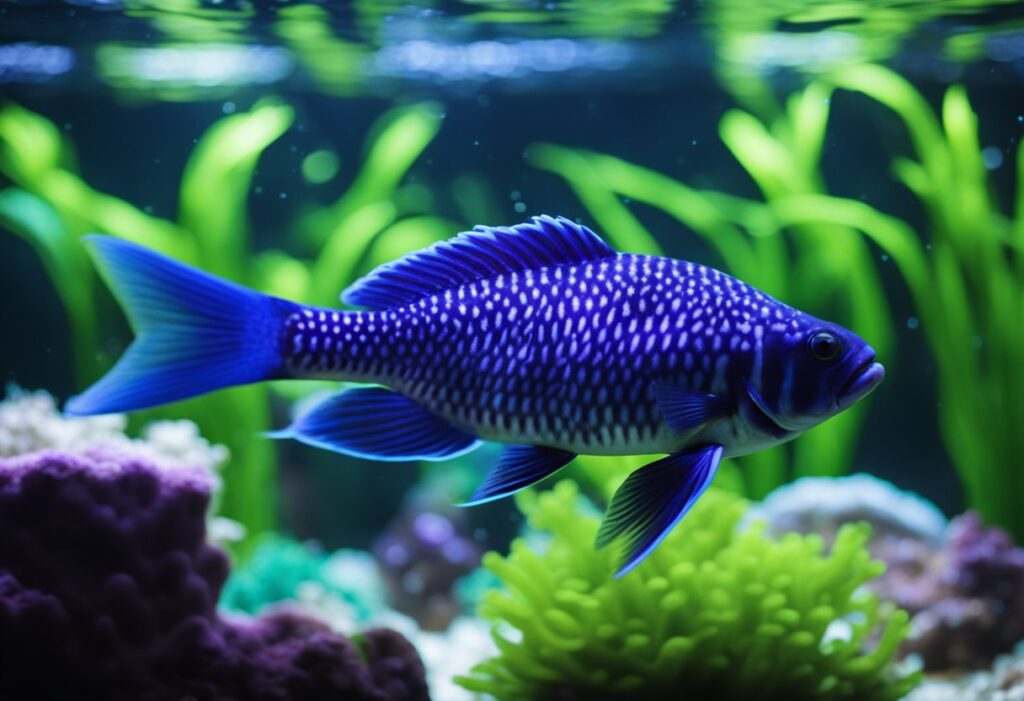
When it comes to Fish Tank Lighting, there are various lighting systems and controls available in the market. These systems and controls help in providing the right amount of light, color spectrum, and intensity required for the aquatic life in the tank.
Automated Light Timers
One of the most important features of a lighting system is the ability to set up an automated light timer. With an automated light timer, you can set a specific time for the lights to turn on and off. This feature is especially useful for those who are unable to maintain a consistent lighting schedule manually. Automated light timers also help in replicating the natural lighting conditions of the aquatic life, which is crucial for their overall health and development.
Adjustable Intensity and Color Spectrum
Another important feature of a lighting system is the ability to adjust the intensity and color spectrum of the lights. Full spectrum lighting is the most commonly used lighting system for aquariums. It provides a wide range of light wavelengths that are similar to natural sunlight, which is essential for the growth and development of aquatic plants and animals.
With adjustable intensity and color spectrum, you can customize the lighting conditions according to the specific needs of your aquatic life. For instance, some plants require more red and blue wavelengths, while others require more green and yellow wavelengths. By adjusting the intensity and color spectrum, you can provide the optimal lighting conditions for your aquatic life.
In conclusion, lighting systems and controls are crucial for the health and development of aquatic life in Fish Tank Lighting. Automated light timers and adjustable intensity and color spectrum are some of the important features to consider when choosing a lighting system for your aquarium.
Setting the Right Aquarium Environment
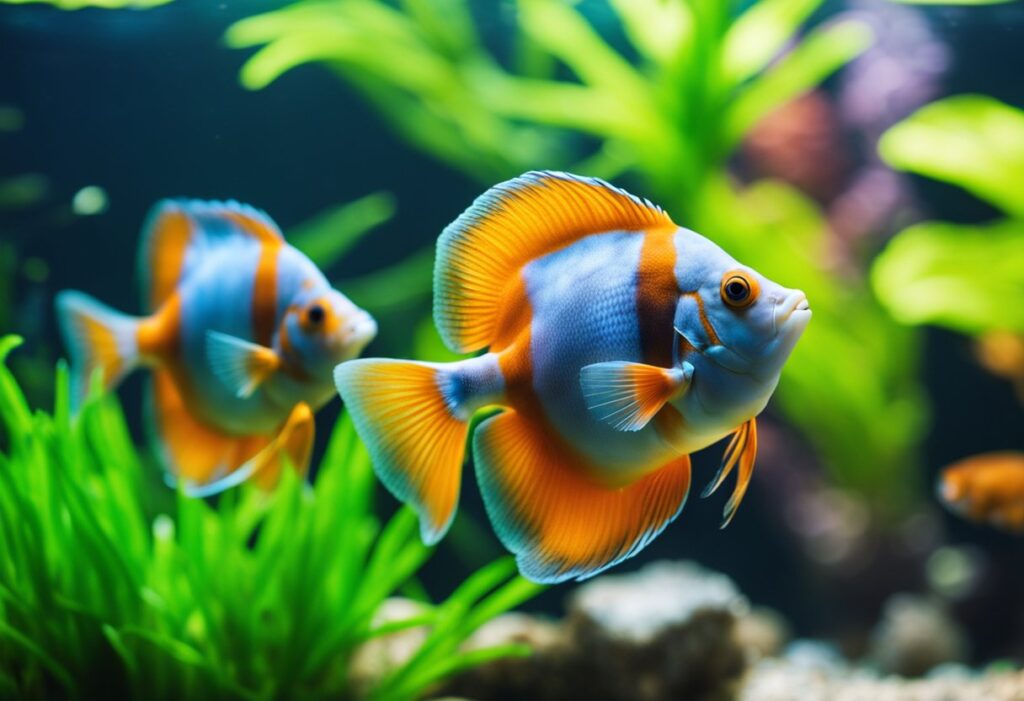
When it comes to fish tank lighting, setting the right environment is crucial for the health and wellbeing of your aquatic pets. There are several factors to consider when creating the perfect environment, such as simulating natural light cycles, temperature, and light intensity.
Simulating Natural Light Cycles
Fish, like all animals, have evolved to live in a specific environment with a certain amount of light and darkness. To keep your fish healthy, it’s important to simulate their natural light cycles as much as possible. This means providing them with a regular day/night cycle that mimics their natural habitat.
To achieve this, we recommend using a timer to regulate the lighting in your aquarium. Set the timer to turn on the lights in the morning and turn them off in the evening, creating a consistent cycle. This will help your fish maintain a healthy circadian rhythm and reduce stress.
Temperature and Light Intensity
In addition to simulating natural light cycles, it’s also important to consider the temperature and light intensity in your aquarium. Different fish species have different temperature and lighting requirements, so it’s important to research the specific needs of your fish and adjust accordingly.
For example, some fish require cooler water temperatures and lower light intensity, while others thrive in warmer water with higher light intensity. Make sure to monitor the temperature and light intensity in your aquarium regularly and adjust as needed to ensure the health and happiness of your fish.
Overall, setting the right aquarium environment is crucial for the health and wellbeing of your fish. By simulating natural light cycles and adjusting the temperature and light intensity as needed, you can create a healthy and happy home for your aquatic pets.
Maintenance and Budget Considerations
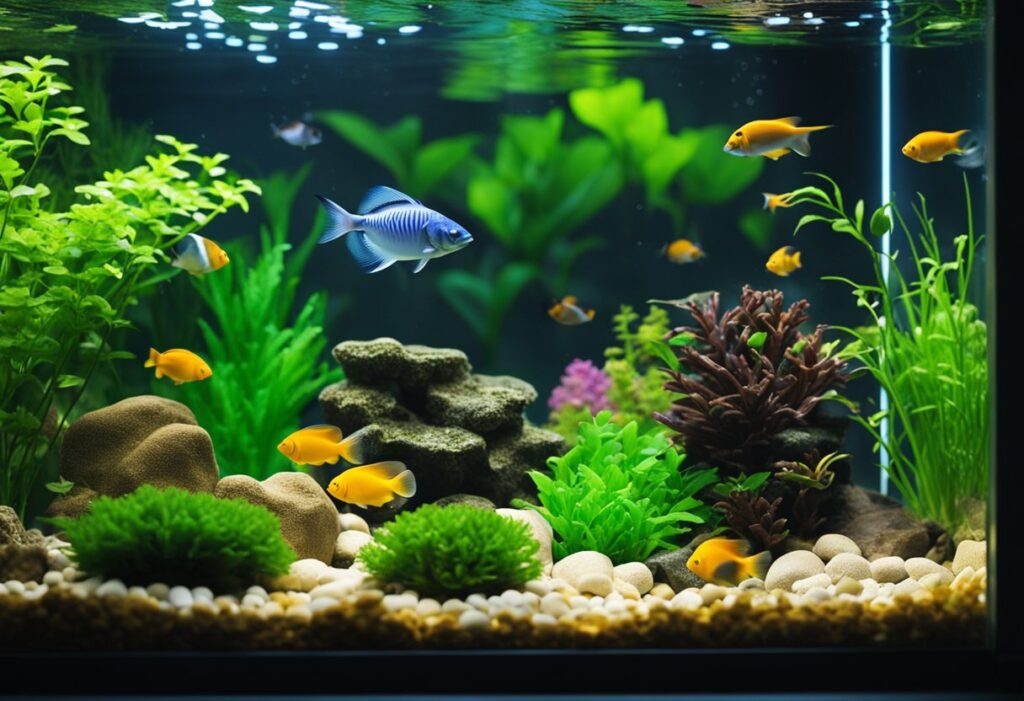
When it comes to fish tank lighting, it’s important to consider both maintenance and budget. In this section, we’ll discuss some key factors to keep in mind.
Energy Efficiency and Lifespan
One important consideration when choosing aquarium lighting is energy efficiency. LED bulbs are a great option for those looking to save on energy costs, as they use significantly less energy than traditional fluorescent bulbs. Additionally, LED bulbs have a longer lifespan, which means you’ll need to replace them less often.
To ensure the longest lifespan for your LED bulbs, it’s important to keep them clean and free of debris. Regularly wiping them down with a soft cloth can help prevent buildup that can reduce their efficiency and lifespan.
Aquarium Lighting on a Budget
If you’re on a budget, there are still plenty of options for fish tank lighting. One option is to opt for a basic fluorescent light fixture, which can be found at most pet stores for a reasonable price. While these fixtures may not be as energy efficient as LED bulbs, they can still provide adequate lighting for your fish tank.
Another budget-friendly option is to look for used or refurbished aquarium lighting fixtures. These can often be found online or at local pet stores for a fraction of the cost of a new fixture. Just be sure to thoroughly inspect any used fixture before purchasing to ensure it’s in good condition.
When it comes to maintenance and budget considerations for fish tank lighting, there are plenty of options to choose from. By keeping energy efficiency and lifespan in mind, as well as exploring budget-friendly options, you can find the right lighting solution for your aquarium without breaking the bank.


